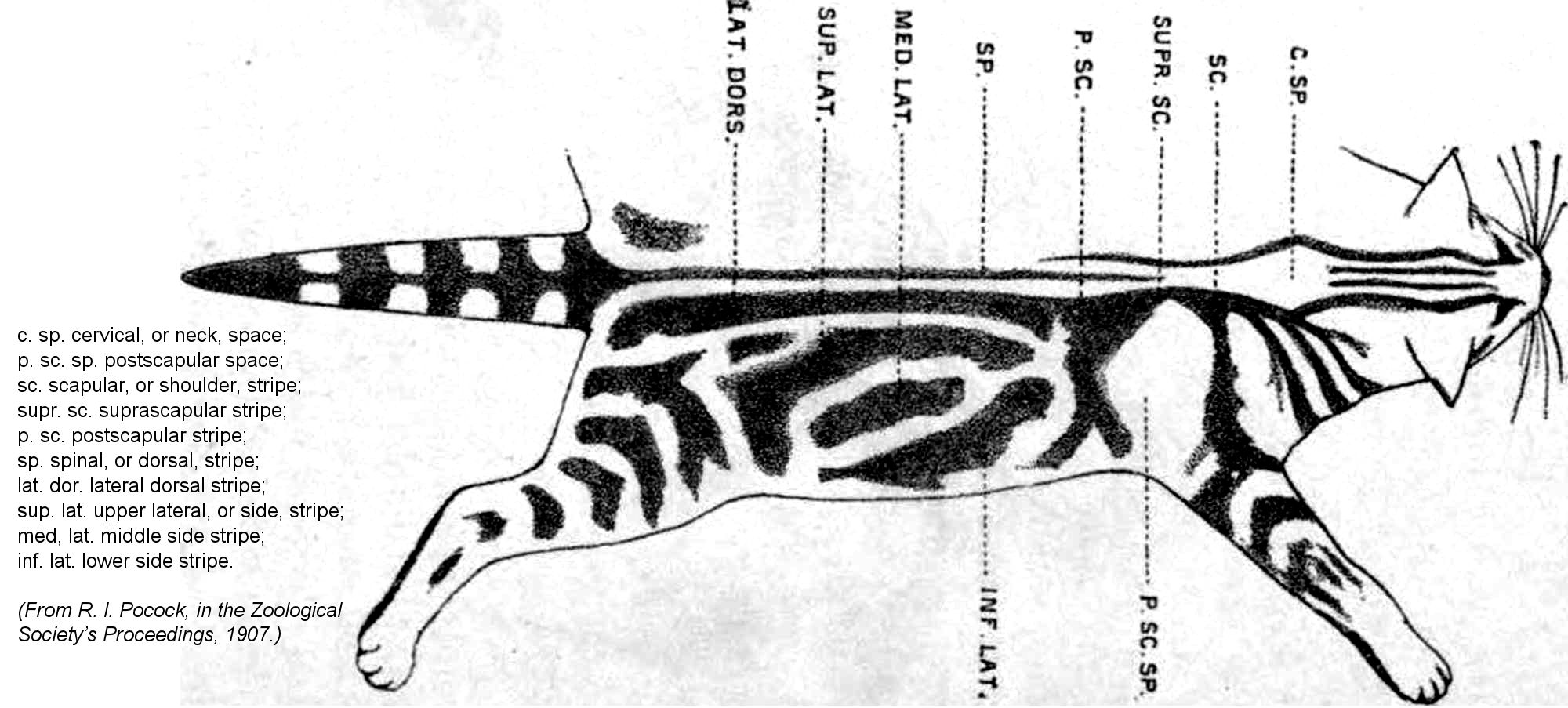
DOMESTICATED CATS
Domesticated breeds of Cats have probably originated from several wild species of the genus Felis. The striped variety of the European Domesticated Cat is, for instance, probably derived either from the Egyptian Wild Cat {F. ocreata), which is known to have been tamed by the ancient Egyptians, or from the European Wild Cat (F. catus or sylvestris), or from both together. Before the intro¬duction of the Persian strain, the striped variety of European Domesticated Cat agreed very closely with the Egyptian Cat, and in Egypt many are stated to be extremely like the latter. As to the origin of the true ‘tabby,’ or blotched variety of Domesti¬cated Cat (fig. 24), there is some difficulty in arriving at a satis¬factory conclusion, although it has been regarded as a distinct species, to which the name F. catus properly belongs. In the Manx breeds, which may be either of the striped or the blotched type, the tail is reduced to a stump, or wanting. In India, where many domesticated breeds are spotted, the Egyptian Wild Cat has probably been the parent stock. A series of skins of the blotched and the striped varieties is shown.
Tortoiseshell Cats are almost invariably females, the male of this breed being sandy. The blue Carthusian Cat is a long-haired breed of a uniform greyish blue colour, with the exception of the lips and soles, which are black. The Persian or Angora breed has also long silky hair and a bushy tail; it is of large size, and the colour is frequently uniform, varying from white to yellowish or greyish, with the lips and soles flesh-coloured, and in some instances one eye yellow and the other blue. There are, however, striped, and also blotched Persians, which suggest that the breed has the same origin as the short-haired Domesticated Cats of Europe. It is, however, possible that the Bokharan Steppe-Cat (F. caudata), an ally of the Egyptian Wild Cat, may have had something to do with the origin of the Persian and Indian breeds. The Abyssinian Domesticated Cat seems to be a rufous phase derived from the Egyptian Wild Cat. Malay Cats have the tail short and kinked; while the Mombas Cat of E. Africa is distinguished by its stiff, wiry hair. In the Paraguay Cat the size is small, the form weasel-¬like, and the hair close, short, and scant, these features being suggestive of affinity with the wild F. eyra of South America.
The Siamese breed is short-haired, with the body fawn-coloured, and the head, limbs, and tail dark brown ; the eyes are blue, and there are two bald spots on the forehead. New-born kittens are white. It is probably also a derivative from the Egyptian Wild Cat, with which it agrees in skull-structure.

The most interesting specimen in the collection is the Chinchilla Persian ‘Silver Lambkin,’ which was the father of the Chinchilla breed, and the most noted stud-cat of its time. This Cat was born in 1889, and died on November 5th, 1906, its sire being ‘Perso,’ and its dam ‘Beauty.’ It was bred by Miss M. Gresham (Mrs. E. T. Bridgewater), and presented by Mrs. D. B. Balding in 1907. The Smoke Persian breed is represented by the skin and skeleton of a male, bred by Miss Power in 1898, which died in 1900. The specimens were presented by Mr. W. F. Heath, The brown Tabby Persian Cat is represented by a male specimen presented by Sergeant S. Ingram in 1902 ; while the Blue Persian breed is shown by ‘Forget-Me-Not,’ a cat formerly belonging to Mrs. Herring, by whom it was presented on its death in 1903. Of the Manx Cat the collection includes a specimen from the Isle of Man, presented by Mr. G. C. Bacon in 1903; and there is also a Tailless Cat from Cornwall, presented by Mr. C. L. Hart Smith in 1903 ; and the skeleton of a third, presented by Mrs. Collins in 1902. The Siamese Cat is represented by an immature specimen bred in England, and presented by Mr. J. Harrington in 1902; while of the Indian Domesticated Cat there is an example purchased in 1903. Mention may also be made of the skeleton of the fore-limbs of a Many-toed, or Polydactyle Cat, having in one limb the normal first toe double and in the other triple. This interesting specimen was presented by Mr. P. E. Rumbelow in 1905.